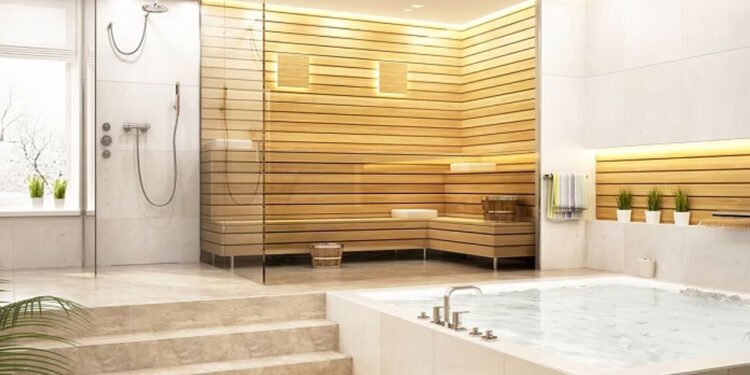A heated bathtub can transform your bathroom into a spa-like retreat, offering warmth, relaxation, and therapeutic benefits. But with so many options available, choosing the perfect heated bathtub can feel overwhelming. From size and shape to additional features, this guide will help you navigate through the key factors to consider when making your decision. Whether you’re looking for a luxurious soak after a long day or a hydrotherapy solution for sore muscles, the perfect heated bathtub is out there for you.
Understand the Benefits of a Heated Bathtub
Before diving into the specifics of choosing a heated bathtub, it’s important to understand the benefits. A heated bathtub does more than just keep your water warm. It enhances relaxation, promotes better circulation, and can provide therapeutic relief from muscle pain and stiffness. Many heated bathtubs come with advanced features, such as jets for hydrotherapy, which can help with chronic pain or injuries. If relaxation and wellness are your goals, a heated bathtub is an excellent investment.
Assess the Space Available in Your Bathroom
The first step in choosing the perfect heated bathtub is assessing the available space in your bathroom. Heated bathtubs come in various sizes, and it’s important to select one that fits well without overwhelming your bathroom.
- Measure the Space: Measure the area where you intend to install the heated bathtub, paying attention to the width, length, and height. This will narrow down your choices and ensure you don’t end up with a tub that’s too large or too small.
- Consider the Layout: Look at the overall layout of your bathroom. Is the space designed for a freestanding tub, a built-in bathtub, or a corner unit? The style of your bathroom will help determine which heated bathtub will fit best.
- Plumbing Requirements: Heated bathtubs often require more advanced plumbing than standard tubs, so make sure to consult a professional to ensure your bathroom can accommodate the new system without complications.
Choose the Right Style for Your Heated Bathtub
Heated bathtubs come in several different styles, each offering unique advantages in terms of aesthetics, comfort, and functionality. Understanding these options will help you select the perfect fit for your bathroom.
- Freestanding Heated Bathtub: A freestanding tub is ideal if you want your bathtub to be the focal point of the bathroom. These tubs are standalone units that can be placed anywhere there is adequate plumbing. They offer a luxurious, contemporary look and often come in sleek, modern designs.
- Built-In Heated Bathtub: Built-in bathtubs are installed against a wall or into a bathroom alcove, making them a space-efficient option. If you’re working with a smaller bathroom, a built-in tub might be the better choice. Many built-in heated bathtubs also come with integrated jets, adding a hydrotherapy element to your soak.
- Corner Heated Bathtub: If you have an unusual bathroom layout or want to maximize space, a corner heated bathtub may be ideal. These bathtubs are designed to fit snugly into the corner of the room and often have extra depth, making them great for longer soaks.
- Drop-In Heated Bathtub: A drop-in bathtub is one where the tub is installed into a frame, with only the interior of the tub exposed. These tubs often have a more custom, luxurious look, as the surrounding frame can be designed to match your bathroom’s aesthetic.
Consider the Material of the Heated Bathtub
The material of your heated bathtub affects not only the durability but also the heat retention, comfort, and style of the tub. Here are the most common materials used in heated bathtubs:
- Acrylic: Acrylic bathtubs are lightweight, affordable, and have excellent heat retention, making them a popular choice for heated bathtubs. They are available in various shapes and sizes and can be easily maintained, but they can be prone to scratches over time.
- Cast Iron: Cast iron tubs are extremely durable and offer superior heat retention, making them ideal for long soaks in a heated bathtub. However, they are quite heavy and require sturdy flooring to support the weight. Cast iron tubs tend to have a classic, traditional look.
- Fiberglass: Fiberglass is a more budget-friendly option. While it’s less durable than acrylic or cast iron, fiberglass heated bathtubs can still provide excellent heat retention and are lightweight, making installation easier.
- Stone Resin: For a high-end, luxurious option, consider a stone resin heated bathtub. This material offers excellent heat retention, a sleek aesthetic, and incredible durability. It’s more expensive but provides a unique blend of function and form.
Evaluate Heating Features and Technology
Not all heated bathtubs are created equal, and their heating technology plays a crucial role in your bathing experience. Understanding these technologies will help you choose the right heated bathtub for your needs.
- Inline Heaters: Inline heaters are built into the plumbing system of the bathtub and work by maintaining the water temperature throughout your soak. This system is ideal if you enjoy long baths and don’t want the water to cool down too quickly.
- Radiant Heating: Radiant-heated bathtubs feature heating elements installed within the tub’s walls. These elements warm the surface of the bathtub itself, providing a more even, gentle heat without directly heating the water. Radiant heating is great for a warm, comforting soak.
- Advanced Hydrotherapy Systems: Some heated bathtubs offer hydrotherapy features such as air or water jets combined with heating technology. These tubs are perfect for relieving muscle tension, recovering from injuries, or enhancing relaxation with a spa-like experience.
Look for Energy Efficiency
Energy efficiency is an important consideration when choosing a heated bathtub. Since these tubs use electricity to maintain water temperature, it’s important to select one that doesn’t drive up your energy bills.
- Energy-Efficient Inline Heaters: Look for inline heaters with energy-saving settings that maintain the water temperature without excessive power use.
- Insulated Tubs: Some heated bathtubs come with insulation to help maintain the water temperature for longer periods without using as much energy. This is especially useful in colder climates where heat loss can be more significant.
- Eco-Friendly Materials: Choosing eco-friendly materials such as acrylic or recycled stone resin can also reduce your overall environmental impact.
Additional Features to Enhance Your Experience
A heated bathtub offers more than just warmth. Its many additional features can enhance your bathing experience, making your soak even more luxurious.
- Massage Jets: Many heated bathtubs come with built-in massage jets that target different areas of the body. These jets can provide a therapeutic massage, which is especially beneficial for those with chronic pain or tight muscles.
- Chromotherapy: Some heated bathtubs feature chromotherapy, which involves using colored lights to promote relaxation and healing. If you’re looking for a full sensory experience, a tub with this feature might be the perfect fit.
- Aromatherapy: Some tubs have built-in aromatherapy systems that diffuse essential oils into the air or water, helping to create a more calming and rejuvenating environment.
- Touchscreen Controls: Modern heated bathtubs often have touchscreen controls, which allow you to adjust water temperature, jet settings, and lighting with ease. This adds a layer of convenience and customization to your bathing experience.
Set a Budget
Heated bathtubs can range in price depending on the material, size, and additional features. It’s essential to set a budget before you begin shopping to ensure you don’t overspend.
- Entry-Level Heated Bathtubs: If you’re on a budget, fiberglass or acrylic heated bathtubs with basic inline heating systems can offer a great balance of affordability and comfort.
- Mid-Range Heated Bathtubs: If you have more to spend, consider looking at tubs with additional features such as jets, chromotherapy, and touchscreen controls. These tubs are often made from more durable materials like cast iron or stone resin.
- High-End Heated Bathtubs: If money is no object, a custom heated bathtub made from premium materials with advanced hydrotherapy features, chromotherapy, and aromatherapy can offer a truly luxurious experience.
Check Warranty and Maintenance Requirements
Finally, always check the warranty and maintenance requirements before purchasing a heated bathtub. A quality heated bathtub should come with a warranty that covers the heating system and other features. Maintenance can vary based on the tub’s material and features, so it’s important to choose one that fits your lifestyle.
- Maintenance: Regular cleaning and proper care will extend the lifespan of your heated bathtub. Some models may require periodic checks of the heating system or jets to ensure they function optimally.
- Warranty: Look for warranties that cover both the heating components and the bathtub’s structural integrity. Longer warranties generally indicate better quality and durability.
Conclusion
Choosing the perfect heated bathtub involves careful consideration of space, style, materials, and features. Whether you’re seeking a luxurious freestanding tub or a space-saving built-in model, the right heated bathtub can transform your bathroom into a haven of warmth and relaxation. With this guide, you’re now well-equipped to make a decision that suits your needs, style, and budget.
If you’re ready to upgrade your bathing experience, take your time to explore your options and consult a professional to ensure a seamless installation. The ultimate heated bathtub awaits, ready to provide you with years of comfort and relaxation.












